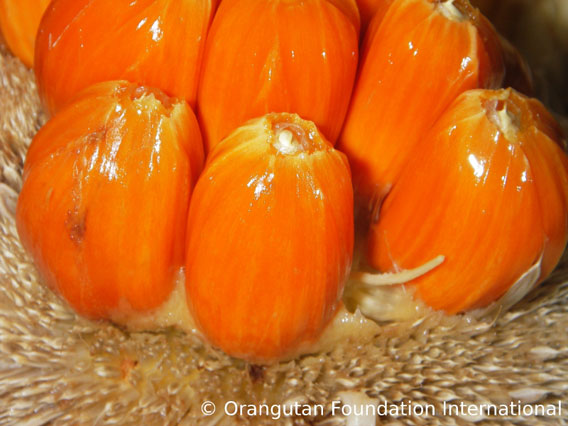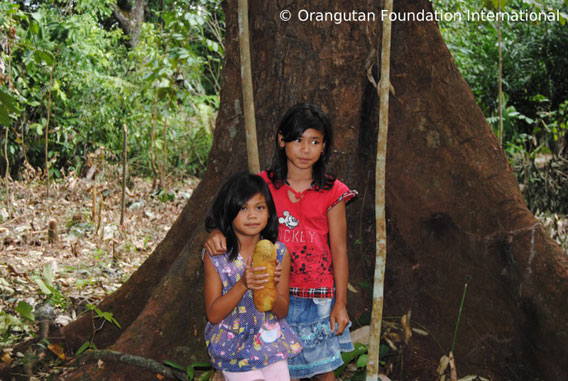With over seven billion people inhabiting the earth and the population endlessly rising, food security is a mounting global issue. As a solution to increasing food scarcity, forests are commonly cleared to make land available for agriculture. Around the world, both industrial farmers and subsistence farmers alike are growing crops on deforested land. However, scientists are finding that the forests themselves may actually be key to providing local populations with higher quality diets. In a paper published recently in the journal Global Environmental Change, Dr. Amy Ickowitz and other researchers at the Center for International Forestry Research (CIFOR), found that African children living closer to forests had higher quality diets than children living in less forested areas.
In 2012, the Food and Agricultural Organization estimated that over two billion people have micronutrient deficient diets. Known as “hidden hunger,” a person affected by micronutrient deficiency may eat an adequate amount of daily calories composed of macronutrients like carbohydrates, protein, and fat, yet be lacking essential vitamins and minerals such as iron, vitamin A, iodine, and zinc.

Map showing the location of the participating communities from the 21 Demographic Health Surveys. Courtesy of Ickowitz et al.
For their study, the researchers examined the nutritional quality of children’s diets in Africa with respect to the amount of forest cover surrounding the areas in which they live. The researchers analyzed the dietary intakes of 93,000 children from across the continent using data recorded in 2010. The researchers looked at three dietary factors that indicate the level of micronutrient intake: dietary diversity, consumption of fruit and vegetables, and consumption of animal products.
The children from the survey were between the ages of one and five, and the food intake of each was recorded over a 24-hour period. The researchers focused their study on the diets of children because children are the most vulnerable to nutrient deficiency. Nutrient-rich diets have been linked to physical and cognitive growth in children, as well as lower illness and mortality rates.
To see if there was a relationship between forest cover and the three dietary quality measurements, the researchers combined 21 Demographic Health Surveys with Geographic Information System (GIS) data from the Global Land Cover Facility. The demographic surveys included the children’s nutritional intake over a 24-hour period, as well as household characteristics such as the educational background of parents, household income, age and gender of the child, and whether or not the child was currently being breastfed. In addition, to control against possible geographical and seasonal food availability constraints, the researchers took into consideration rural versus urban households, the month the survey was conducted, and the climate and altitude of the surveyed households.
The researchers found that more forest cover was associated with nutritiously diverse diets. Their results showed that consumption of fruits and vegetables increased as the amount of tree cover near communities increased. Nutritional benefits associated with tree density increased up to a tree cover of 45 percent, after which there was no significant difference. Consumption of animal products such as dairy, meat, and eggs was not shown to correlate with amount of tree cover.

Mentawa fruit is the product of a favorite wild agroforestry tree. Photo courtesy of Orangutan Foundation International.
The researchers suggested three potential ways in which living close to a forest is beneficial for providing well-balanced diets. People who live close to forests may have easier access to more diverse and nutritious foods such as wild fruits, leafy greens, grubs, snails, and wild meat. Secondly, farmers who practice agroforestry, the method of growing trees and shrubs alongside crops, may have more access to fruits and nuts via the trees on their land. Lastly, agricultural techniques commonly used in forests, such as crop rotation and planting a variety of crops, may provide local communities with more diverse food sources.
Low-income households tend to have the most difficulty accessing nutritious food, especially in rural areas. In some rural areas, while the production of nutritious foods may be relatively inexpensive, market prices can be high due to transportation and labor costs. Therefore, low-income households are often excluded from accessing nutritious food. Yet, low-income households in rural forested regions who are able to farm their own food or obtain fruits and nuts from the surrounding forests may have higher quality diets than low-income households in less forested areas. This study found that dietary quality was influenced more greatly by forest cover in rural communities than in urban communities.
“Rural communities have lower dietary diversity and consumption of the different food groups than the urban areas,” Ickowitz told mongabay.com. “Although we do not report it in the paper, we did try restricting our sample to only rural households and found that tree cover had a stronger effect on rural households than in the mixed rural and urban sample.”

Girls in Borneo holding a cempadak fruit under a durian tree. Photo courtesy of Orangutan Foundation International.
In addition, children from wealthier households and children whose parents had higher educational backgrounds tended to eat more diverse diets of fruit, vegetable, and animal products. Climate and elevation conditions affected dietary consumption independently of tree cover. The researchers found that children living at higher elevations had more diverse diets of fruit and vegetables, but consumed fewer animal products.
This research supports other studies that have found an association between the dietary quality of a community and its surrounding tree density. However, many questions remain. For instance, the researchers could not determine the difference between natural forests and agro-forests. Therefore, they could not distinguish whether people collected more nutritious food from their agro-farms or the surrounding natural forests. In addition, the study does not discuss the potential indirect benefits that tree cover may provide to food production through ecosystem services such as soil and nutrient regulation and hydrological services. Whether or not there are benefits to purchasing food from forested regions also remains unknown.
Recently, there has been a focus on the quantity of food production and food consumption, with less attention given to the quality and nutritional value of food. The definition of food security created at the 1996 World Food Summit emphasizes the accessibility of nutritious food, and considers both quality and quantity. This research may provide crucial information for further investigation of solutions to reaching food security goals.
“I think that our results are important for policy makers to take into account when they are considering ‘development’ on forested land in their countries with the objective of pursuing food security,” Ickowitz said. “Our results show that they may actually be sacrificing the nutritional quality of peoples’ diets and thus reducing their overall dietary security.”
Citations:
- Ickowitz, Amy, Bronwen Powell, Mohammad A. Salim, and Terry C.h. Sunderland. “Dietary Quality and Tree Cover in Africa.” Global Environmental Change(2013)
Related articles
Through careful management, indigenous people have shaped Asian rainforests for 11,000 years

(01/28/2014) Humans have been actively managing vast areas of Southeast Asia’s forests for longer than previously believed, according to research by paleoecologists from the United Kingdom presented in the current Journal of Archaeological Science. Strong evidence suggests that humans in Borneo, Sumatra, Java, Thailand and Vietnam have engaged in agricultural practices for the last 11,000 years. These findings may help bolster the claims of local indigenous peoples under threat of eviction from their traditional lands.
Still hope for tropical biodiversity in human modified landscapes
(04/09/2013) As primary forests become increasingly rare and expensive to protect, many ecologists are looking to better management of Human Modified Landscapes (HMLs) to shepherd and shield biodiversity in the tropics. Secondary forests, selectively logged forests and lands devoted to sustainable agriculture already play an important role in conservation efforts. However, the idea that HMLs will serve as a “Noah’s Ark” for biodiversity, is controversial.
From slash-and-burn to Amazon heroes: new video series highlights agricultural transformation

(01/31/2013) A new series of short films is celebrating the innovation of rural farmers in the Manu region of Peru. Home to jaguars, macaws, and tapirs, the Manu region is also one of the top contenders for the world’s most biodiverse place. It faces a multitude of threats from road-building to mining to gas and oil concessions. Still the impact of smallscale slash-and-burn farming—once seen as the greatest threat to the Amazon and other rainforest—may be diminishing as farmers, like the first film’s Reynaldo (see below), turn to new ways of farming, ones that preserve the forest while providing a better life overall.
Bird diversity at risk if ‘agroforests’ replaced with farmland

(09/13/2012) Agroforests contain much higher levels of bird diversity than their open agricultural counterparts, according to new research from the University of Utah. If large forests and agroforests continue to be replaced by simple open farms, bird communities will become much less specialized and entire groups may become extinct. Important roles for birds, such as pollination, pest control or seed dispersal, may remain unfilled if ongoing trends toward open agriculture continues and biodiversity decreases.